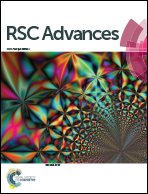Morphology-dependent enhancement of template-guided tunable polyaniline nanostructures for the removal of Cr(vi)†
Abstract
Three nanostructured polyanilines (PANIs) with different morphologies, including nanofibers, nanotubes and nanosheets, have been successfully synthesized using MnO2 with tunable morphologies as the reactive templates. A growth mechanism is proposed to explain the evolution of the polyaniline morphology based on the reactive templates. The obtained PANIs were characterized by SEM, FT-IR, Raman, XRD, elemental analysis, BET and XPS. The adsorption capacities of three nanostructured PANIs with different morphologies were investigated towards the rapid removal of hexavalent chromium Cr(VI). Compared with PANI nanofibers without any templates, the template-guided PANIs showed better adsorption capacities. It was found that the adsorption capacities followed an order of PANI nanosheets > PANI nanotubes > PANI nanofibers. PANI nanosheets were the most effective adsorbent and the adsorption removal efficiency was 97.2% to remove 40 mg L−1 Cr(VI) from aqueous solution. The maximum adsorption capacity determined from the Langmuir isotherm model was 263.2 mg g−1. This finding suggests that the template-guided tunable polyaniline nanostructures method may be useful to enhance the adsorption capacity for the removal of Cr(VI).


 Please wait while we load your content...
Please wait while we load your content...